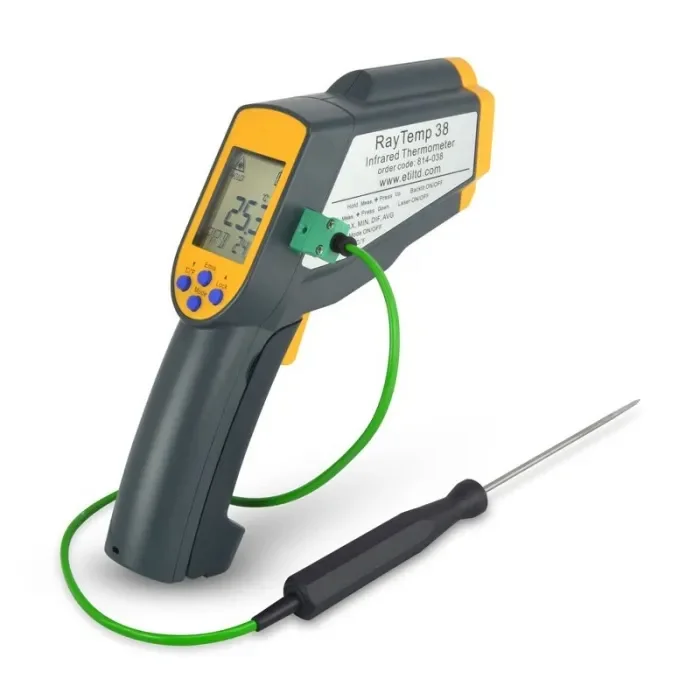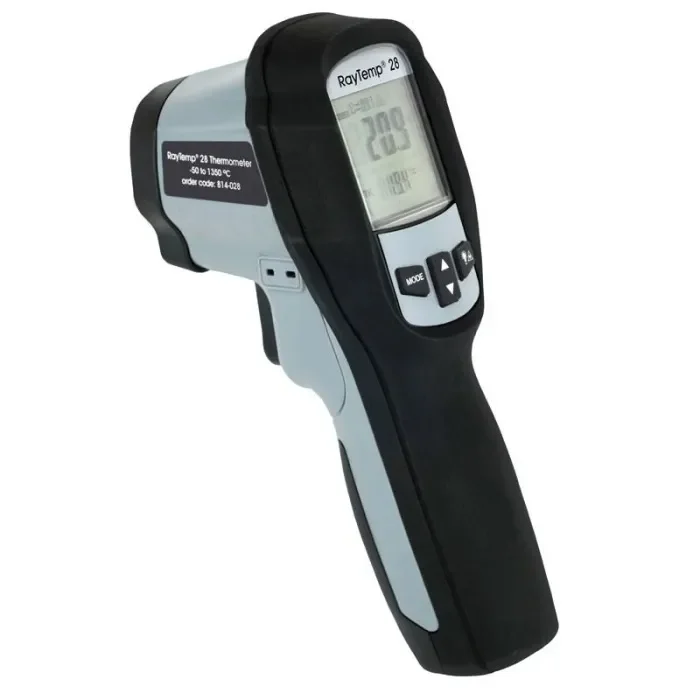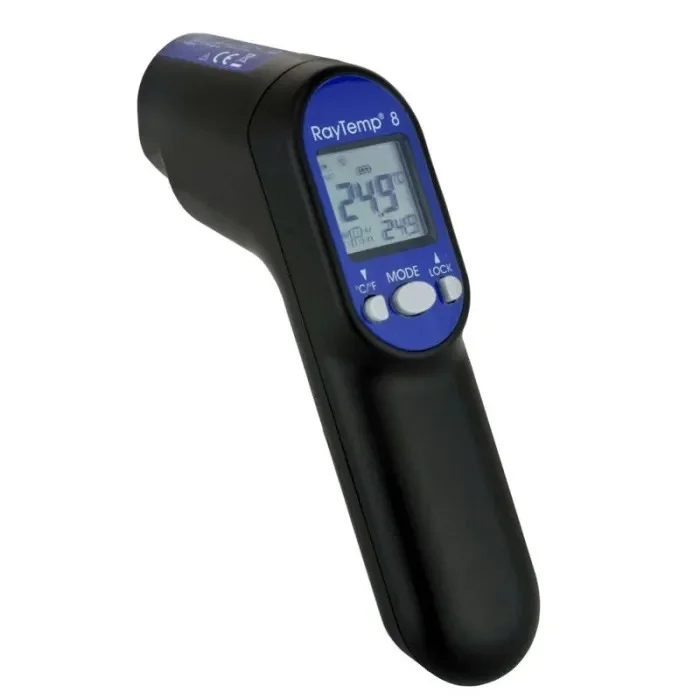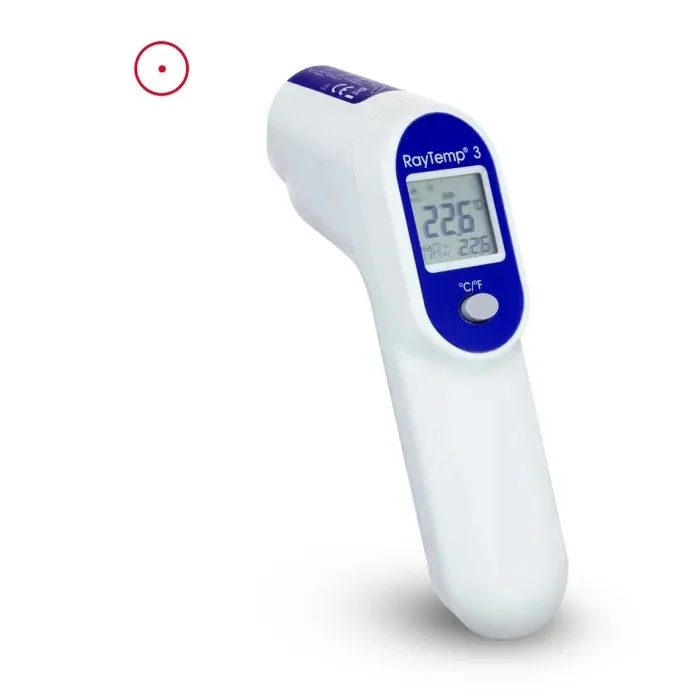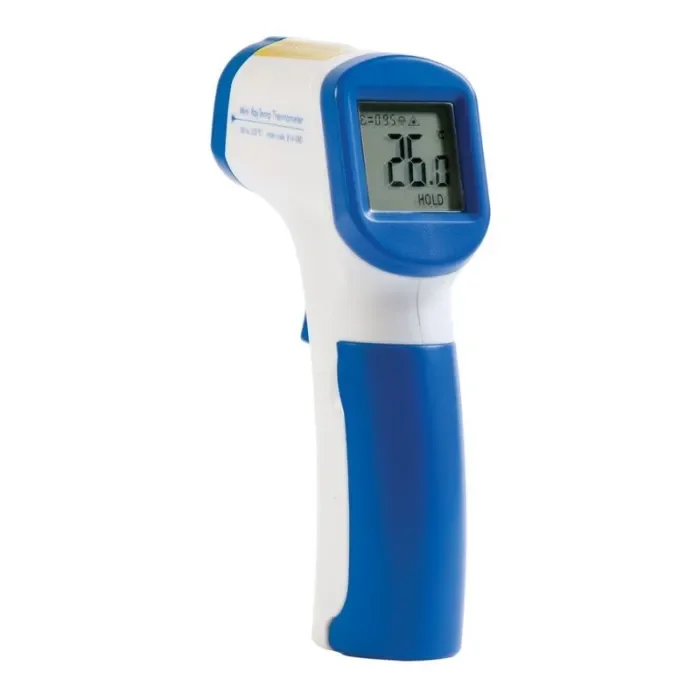Infrared Thermometer Technical Information
Non-contact Temperature Sensors
These detectors measure the amount of radiation emitted by a surface. As the temperature of a body increases, the amount of infrared emitted and its average frequency also goes up.
The target material radiating efficiency will have a bearing on the reading and the emissivity (between 0 and 100%) needs to be known. This rating can vary between 95% for an efficient surface to 20% for polished metal.
The emissivity of the surface must be known. Varying oxidation or roughness will affect the reading. A coating is often applied to ensure a certain emissivity figure.
Care needs to be taken to avoid reading contamination from sources other than the target. A detector will have a certain field of view which can be altered to concentrate on the target.
One significant advantage of infrared temperature measurement is that it is non-contact. Thus moving bodies, fragile or wet surfaces and very aggressive media can be measured with relative ease. Very large surfaces can also be measured and simply averaged, or hot spots detected without masses of wiring and detectors.
Only surface temperatures can be read. If the bulk temperature of a process is to be recorded a sheath must be inserted into the process and it must act as a sighting target.
Infrared thermometers can record high temperatures (up to 3000 °C), well above Thermocouples and Resistance Thermometers (RTDs) although they suffer from higher inaccuracies and other problems such as radiant heat.
Is an infrared thermometer accurate?
The accuracy of an infrared thermometer depends on various factors, including its quality, calibration, and the conditions under which it is used. Infrared thermometers can provide accurate temperature measurements when used within their specified range and under appropriate conditions. However, factors such as distance from the target, emissivity of the surface being measured, and ambient temperature can affect accuracy.
High-quality infrared thermometers that are properly calibrated and used within their recommended range can provide accurate temperature measurements within a certain tolerance. It’s essential to follow the manufacturer’s guidelines for calibration and usage to ensure accurate results.
For critical applications where precision is crucial, infrared thermometers may need periodic calibration to maintain accuracy. Overall, when used correctly, infrared thermometers can provide reliable and convenient temperature measurements for a wide range of applications.
What are infrared thermometers used for?
Infrared thermometers are used for non-contact temperature measurement in various applications across different industries. Some common uses include:
• Medical applications: Infrared thermometers are widely used in healthcare settings for quick and non-invasive measurement of body temperature, particularly in situations where traditional thermometers may not be practical or safe.
• Industrial processes: Infrared thermometers are used for monitoring and controlling temperatures in industrial processes such as manufacturing, food processing, and HVAC systems. They can measure temperatures of machinery, equipment, and materials without the need for direct contact.
• Electrical maintenance: Infrared thermometers are used by electricians and maintenance technicians to detect hot spots in electrical systems, which can indicate potential issues such as overheating or electrical faults.
• Automotive: Infrared thermometers are used in automotive diagnostics for measuring temperatures of engines, exhaust systems, brakes, and other components without the need for disassembly.
• Food safety: Infrared thermometers are used in food processing and food service industries to monitor temperatures during cooking, cooling, and storage processes to ensure food safety and quality.
• Building inspections: Infrared thermometers are used for building inspections to detect thermal leaks, insulation deficiencies, and moisture problems in walls, ceilings, and other building components.
• Firefighting: Infrared thermometers are used by firefighters to assess temperature conditions and monitor fire spread in firefighting operations.
Overall, the non-contact nature and versatility of infrared thermometers make them valuable tools for temperature measurement in a wide range of applications.
What is the most accurate way to take temperature with an infrared thermometer?
To ensure the most accurate temperature measurements with an infrared thermometer, follow these guidelines:
• Proper distance: Maintain the recommended distance between the thermometer and the target surface as specified by the manufacturer. Typically, this distance is around 1-2 inches (2.5-5 centimetres).
• Clean surface: Ensure that the surface being measured is clean and free from any obstructions or contaminants that could affect the accuracy of the reading.
• Emissivity setting: Adjust the emissivity setting on the thermometer to match the emissivity of the target surface. Emissivity is a measure of how efficiently a surface emits infrared energy. Most infrared thermometers allow you to adjust the emissivity setting to compensate for different materials.
• Avoid reflections: Avoid measuring surfaces that are highly reflective, such as mirrors or shiny metals, as they can reflect infrared radiation from surrounding objects and give inaccurate readings.
• Avoid extreme environments: Infrared thermometers may not provide accurate measurements in extreme environmental conditions, such as extremely high or low temperatures, or in areas with high levels of electromagnetic interference.
• Average multiple readings: Take multiple readings from different spots on the target surface and average the results to minimise the effects of localised temperature variations.
• Calibration: Periodically calibrate the infrared thermometer according to the manufacturer’s instructions to ensure accuracy.
By following these guidelines, you can maximise the accuracy of temperature measurements taken with an infrared thermometer.
Where do you point an infrared thermometer?
You should point an infrared thermometer directly at the surface of the object or area from which you want to measure the temperature. Ensure that the sensor of the thermometer is aimed at the spot on the surface that you want to measure, maintaining the appropriate distance as specified by the manufacturer’s guidelines.
Purchase Infrared Temperature Sensors
We offer a full range of infrared temperature sensors available to purchase on our online store.
RayTemp 38 Infrared Thermometer
View ProductRayTemp 28 Infrared Thermometer
View ProductRayTemp 8 Infrared Thermometer
View ProductRayTemp 3 Infrared Thermometer
View ProductMini RayTemp Infrared Thermometer
View ProductSubmit an Enquiry
"*" indicates required fields

